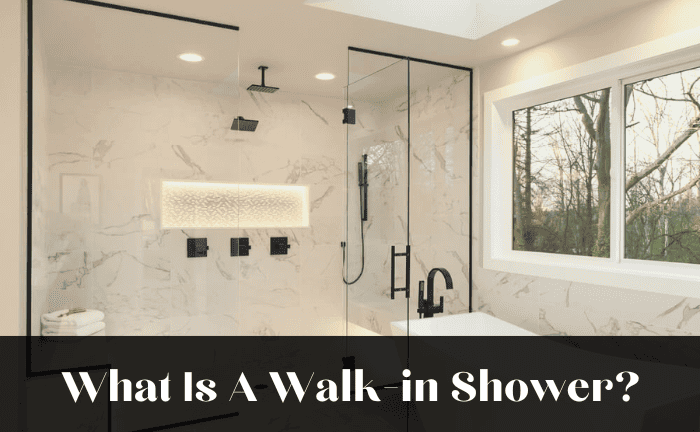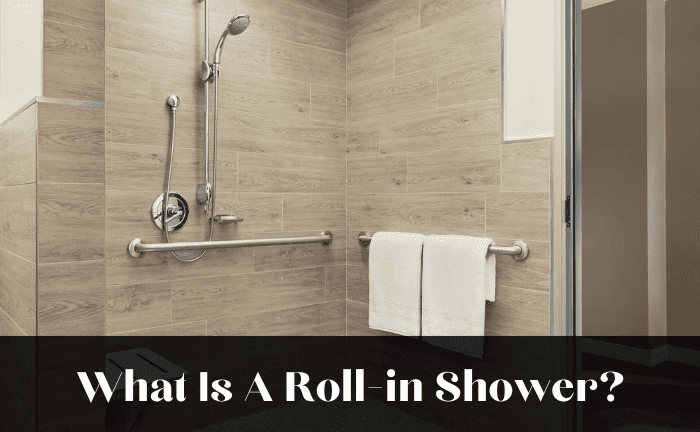If you’re planning a bathroom renovation, you may have heard the terms “walk-in shower” and “roll-in shower” thrown around. While both options offer accessible showering for people with mobility issues, they are not interchangeable.
Walk-in Shower and a Roll In shower have various prominent differences, including
- Entryway
- Size
- Controls
- Amenities
In this writing, you’ll learn the differences between a walk-in shower and a roll-in shower and help you determine the best option for your needs.
What Is A Walk-in Shower?

A walk-in shower is a type of shower that has a low or zero-threshold entry. This means that you can walk into the shower without having to step over a high bathtub wall or ledge.
Walk-in showers are a popular option for people who want to create a modern, open look in their bathroom, as they can be designed to blend seamlessly with the rest of the bathroom floor.
Now that you’ve covered the basics of a walk-in shower let’s explore the pros and cons to help you decide if it’s the right choice for your bathroom remodel.
Pros of Walk-In Showers
- Accessibility: One of the most significant advantages of a walk-in shower is its accessibility. Unlike traditional showers or bathtubs, a walk-in shower has a low or no threshold, making it easy to step in and out without tripping or falling.
- Customization: Walk-in showers come in various sizes, styles, and designs, so you can customize them to fit your unique preferences and needs. You can choose from different tile patterns, colors, and textures to create a beautiful, modern bathroom space.
- Low Maintenance: Since walk-in showers have fewer nooks and crannies than traditional showers; they are easier to clean and maintain. With proper care and maintenance, your walk-in shower can look and function like new for years.
- Increased Home Value: Installing a walk-in shower can increase the value of your home. Potential buyers may view a walk-in shower as a desirable feature that adds style and functionality to the bathroom.
Cons of Walk-In Showers
- Water Containment: Unlike traditional showers with a bathtub or shower pan, a walk-in shower typically has an open floor allowing water to splash and escape. While this can be prevented with proper installation and design, it’s essential to ensure that your bathroom has adequate drainage to avoid water damage.
- Higher Cost: Walk-in showers can be more expensive than traditional showers, especially if you want to include additional features such as benches or multiple showerheads. However, the increased functionality and accessibility may be worth the extra cost.
- Slippery Floors: With an open floor, walk-in showers can be slippery when wet, increasing the risk of falls. To prevent this, you can install slip-resistant flooring or add grab bars for support.
What Is A Roll-in Shower?

A roll-in shower is a type of shower that is designed to be completely accessible to people with mobility issues. Unlike a walk-in shower, which may have a low or zero-threshold entry, a roll-in shower has a flat floor with no curb or edge.
This allows someone in a wheelchair to simply roll into the shower without worrying about any obstacles. Roll-in showers are often found in hospitals and other medical facilities, but they can also be installed in residential homes.
Now that you’ve covered the pros and cons of walk-in showers, let’s explore the pros and cons of roll-in showers to help you decide if it’s the right choice for your bathroom remodel.
Pros of Roll-In Showers
- Wheelchair Accessibility: The most significant advantage of a roll-in shower is that it is wheelchair accessible. The low or no threshold design of the shower allows for easy access for individuals with mobility issues, including those who use wheelchairs or walkers.
- Safety: Roll-in showers are designed with safety in mind. They eliminate the need for stepping over a high threshold or curb, reducing the risk of falls and injuries. Additionally, you can install grab bars and non-slip flooring to enhance safety further.
- Versatility: Roll-in showers can be customized to fit your unique needs and preferences. You can choose from various sizes, designs, and features to create a beautiful, functional bathroom space that meets your requirements.
- Increased Home Value: Like walk-in showers, roll-in showers can increase the value of your home, especially if you are looking to sell or rent it out. They are considered desirable features for individuals with disabilities or mobility issues.
Cons of Roll-In Showers
- Space Requirements: Roll-in showers require more space than traditional or walk-in showers. They need enough space to accommodate a wheelchair or mobility device, which can be challenging in smaller bathrooms.
- Higher Cost: Roll-in showers can be more expensive than traditional or walk-in showers due to their specialized design and installation requirements. However, the increased accessibility and safety benefits may outweigh the extra cost.
- Water Containment: Like walk-in showers, roll-in showers can have issues with water containment due to their open design. Proper installation and innovation are essential to prevent water from splashing and causing damage.
Related: What Is The Difference Between A Walk In Shower And A Wet Room?
Differences Between Walk-In and Roll-In Showers
Now that you’ve gone through the basics of what a walk-in shower and a roll-in shower are, let’s take a closer look at the critical differences between the two.
Entryway
The most apparent difference between a walk-in shower and a roll-in shower is the entryway. Walk-in showers typically require users to step over a low threshold to enter the shower area.
In contrast, roll-in showers have a completely barrier-free entrance that allows users to roll directly into the shower area.
Size
Another critical difference between walk-in showers and roll-in showers is the size. Walk-in showers can be relatively compact, as they are typically designed to fit within the existing space of a bathroom.
Roll-in showers, on the other hand, generally are more extensive to accommodate the needs of people who use mobility devices.
Controls and Amenities
Finally, walk-in showers and roll-in showers may differ in terms of the controls and amenities that they offer. Walk-in showers may feature a wider variety of showerheads, management, and other features, as they are designed to be customized to meet the needs and preferences of individual users.
Roll-in showers may be more limited in parts as they provide a barrier-free entryway.
Related: What Is The Best Type Of Walk-in Shower?
Final Verdict
In conclusion, a walk-in shower and a roll-in shower are two distinct options for accessible showering. While they share some similarities, such as ease of use and low-maintenance design, they are not interchangeable. By understanding the differences between these two options, you can decide which is right for you.
